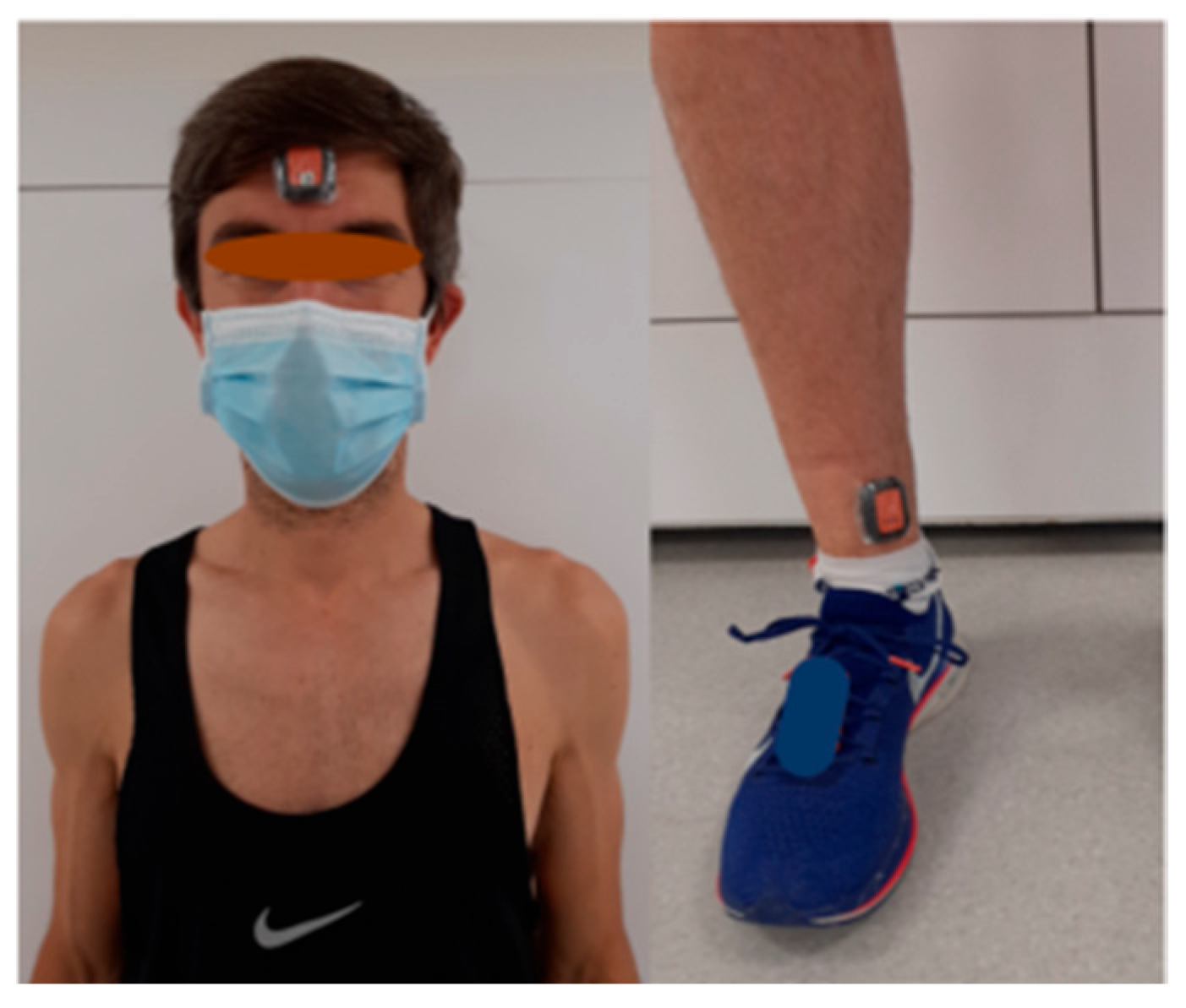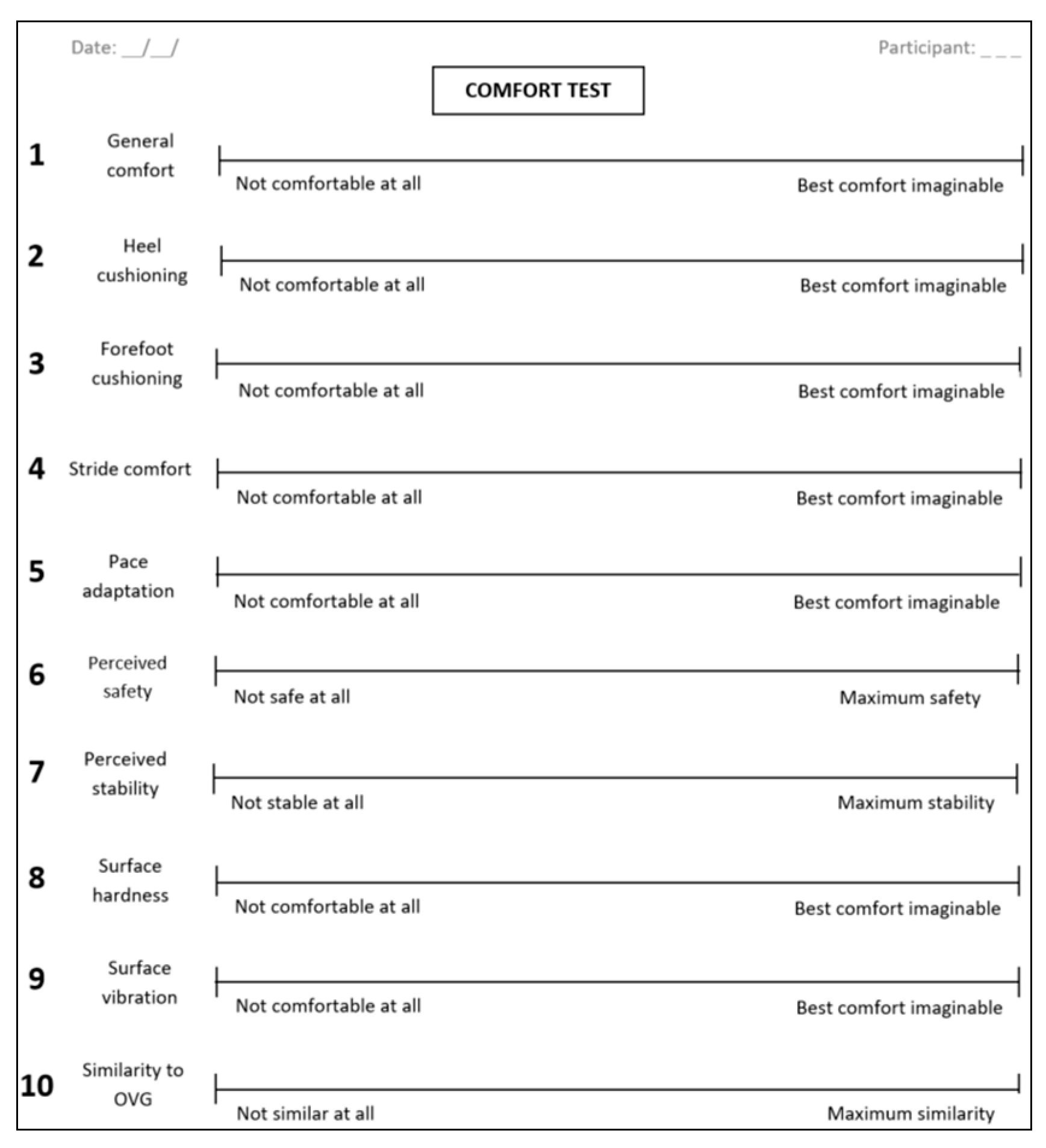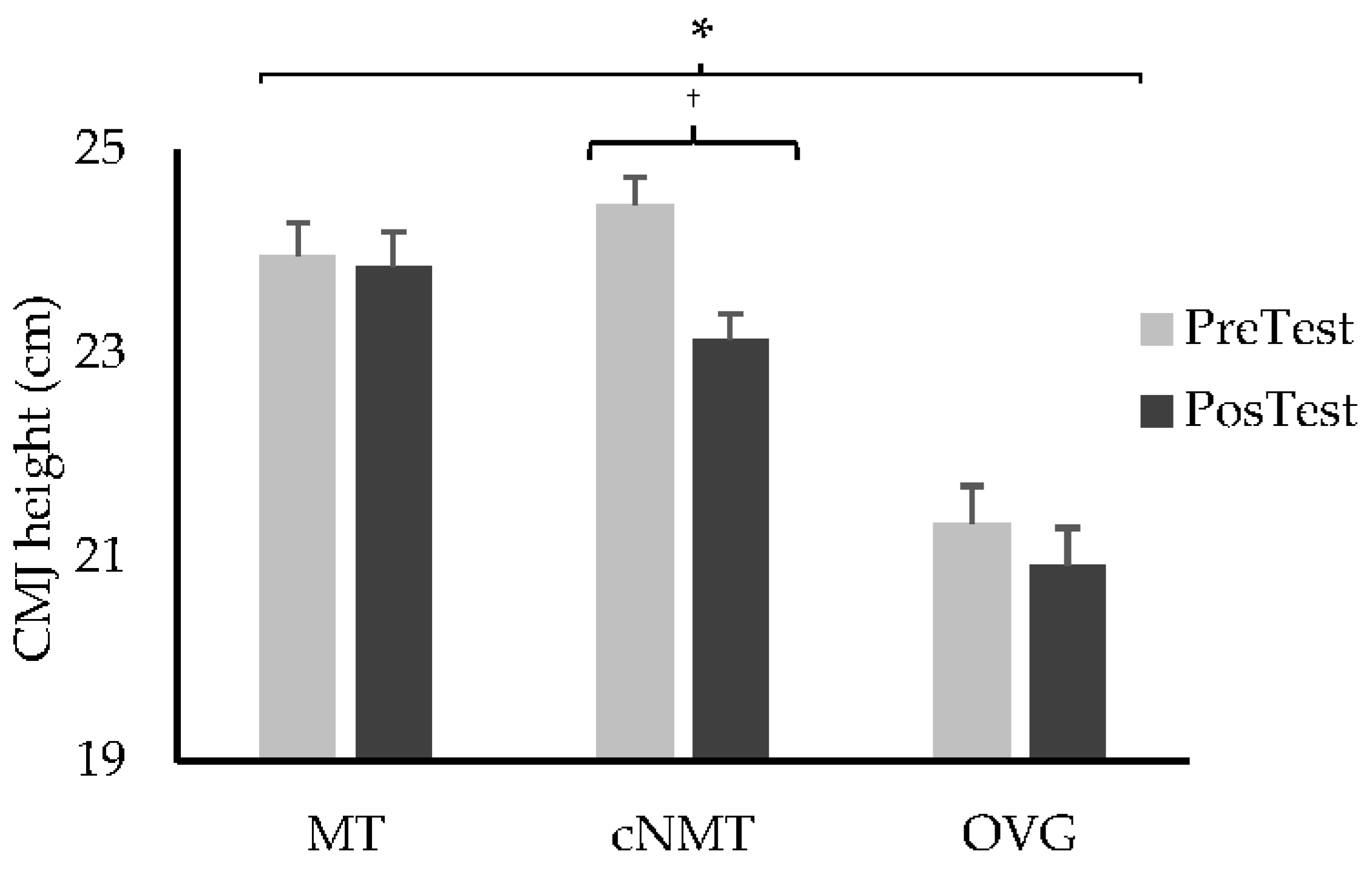Changes in Frequency Domain Accelerations During Prolonged Running on Different Surfaces
Abstract
1. Introduction
2. Materials and Methods
2.1. Participants
2.2. Study Protocol
2.3. Data Collection
2.4. Statistical Analysis
3. Results
3.1. Running Surface Effect
3.2. Prolonged Running Effect
4. Discussion
5. Conclusions
Author Contributions
Funding
Institutional Review Board Statement
Informed Consent Statement
Data Availability Statement
Acknowledgments
Conflicts of Interest
References
- Bruseghini, P.; Tam, E.; Monte, A.; Capelli, C.; Zamparo, P. Metabolic and kinematic responses while walking and running on a motorised and a curved non-motorised treadmill. J. Sports Sci. 2019, 37, 396–403. [Google Scholar] [CrossRef] [PubMed]
- Catalá-Vilaplana, I.; Encarnación-Martínez, A.; Camacho-García, A.; Sanchis-Sanchis, R.; Pérez-Soriano, P. Influence of surface condition and prolonged running on impact accelerations. Sports Biomech. 2023, 24, 1064–1078. [Google Scholar] [CrossRef]
- Edwards, R.B.; Tofari, P.J.; Cormack, S.J.; Whyte, D.G. Non-motorized Treadmill Running Is Associated with Higher Cardiometabolic Demands Compared with Overground and Motorized Treadmill Running. Front. Physiol. 2017, 8, 914. [Google Scholar] [CrossRef]
- Stevens, C.J.; Hacene, J.; Wellham, B.; Sculley, D.V.; Callister, R.; Taylor, L.; Dascombe, B.J. The validity of endurance running performance on the Curve 3(TM) non-motorised treadmill. J. Sports Sci. 2015, 33, 1141–1148. [Google Scholar] [CrossRef]
- Schoenmakers, P.P.; Crisell, J.J.; Reed, K.E. Physiological and Perceptual Demands of Running on a Curved Nonmotorized Treadmill Compared with Running on a Motorized Treadmill Set at Different Grades. J. Strength Cond. Res. 2020, 34, 1197–1200. [Google Scholar] [CrossRef]
- Stevens, C.J.; Hacene, J.; Sculley, D.V.; Taylor, L.; Callister, R.; Dascombe, B. The reliability of running performance in a 5 km time trial on a non-motorized treadmill. Int. J. Sports Med. 2015, 36, 705–709. [Google Scholar] [CrossRef] [PubMed]
- Frishberg, B.A. An analysis of overground and treadmill sprinting. Med. Sci. Sports Exerc. 1983, 15, 478–485. [Google Scholar] [CrossRef] [PubMed]
- Baur, H.; Hirschmüller, A.; Mueller, S.; Gollhofer, A.; Mayer, F. Muscular activity in treadmill and overground running. Isokinet. Exerc. Sci. 2007, 15, 165–171. [Google Scholar] [CrossRef]
- Montgomery, G.; Abt, G.; Dobson, C.; Smith, T.; Ditroilo, M. Tibial impacts and muscle activation during walking, jogging and running when performed overground, and on motorised and non-motorised treadmills. Gait Posture 2016, 49, 120–126. [Google Scholar] [CrossRef]
- García-Pérez, J.A.; Pérez-Soriano, P.; Llana Belloch, S.; Lucas-Cuevas, A.G.; Sánchez-Zuriaga, D. Effects of treadmill running and fatigue on impact acceleration in distance running. Sports Biomech. 2014, 13, 259–266. [Google Scholar] [CrossRef]
- Dixon, S.J.; Collop, A.C.; Batt, M.E. Surface effects on ground reaction forces and lower extremity kinematics in running. Med. Sci. Sports Exerc. 2000, 32, 1919–1926. [Google Scholar] [CrossRef]
- Aubol, K.G.; Hawkins, J.L.; Milner, C.E. Tibial Acceleration Reliability and Minimal Detectable Difference During Overground and Treadmill Running. J. Appl. Biomech. 2020, 36, 457–459. [Google Scholar] [CrossRef] [PubMed]
- Waite, N.; Goetschius, J.; Lauver, J.D. Effect of Grade and Surface Type on Peak Tibial Acceleration in Trained Distance Runners. J. Appl. Biomech. 2020, 37, 2–5. [Google Scholar] [CrossRef]
- Boey, H.; Aeles, J.; Schütte, K.; Vanwanseele, B. The effect of three surface conditions, speed and running experience on vertical acceleration of the tibia during running. Sports Biomech. 2017, 16, 166–176. [Google Scholar] [CrossRef]
- Hamill, J.; Derrick, T.R.; Holt, K.G. Shock attenuation and stride frequency during running. Hum. Mov. Sci. 1995, 14, 45–60. [Google Scholar] [CrossRef]
- van der Worp, M.P.; ten Haaf, D.S.M.; van Cingel, R.; de Wijer, A.; Nijhuis-van der Sanden, M.W.G.; Staal, J.B. Injuries in runners; a systematic review on risk factors and sex differences. PLoS ONE 2015, 10, e0114937. [Google Scholar] [CrossRef] [PubMed]
- Abt, J.P.; Sell, T.C.; Chu, Y.; Lovalekar, M.; Burdett, R.G.; Lephart, S.M. Running Kinematics and Shock Absorption Do Not Change After Brief Exhaustive Running. J. Strength Cond. Res. 2011, 25, 1479. [Google Scholar] [CrossRef] [PubMed]
- Clansey, A.C.; Hanlon, M.; Wallace, E.S.; Nevill, A.; Lake, M.J. Influence of tibial shock feedback training on impact loading and running economy. Med. Sci. Sports Exerc. 2014, 46, 973–981. [Google Scholar] [CrossRef]
- Darch, L.; Chalmers, S.; Wiltshire, J.; Causby, R.; Arnold, J. Running-induced fatigue and impact loading in runners: A systematic review and meta-analysis. J. Sports Sci. 2022, 40, 1512–1531. [Google Scholar] [CrossRef]
- Van den Berghe, P.; Six, J.; Gerlo, J.; Leman, M.; De Clercq, D. Validity and reliability of peak tibial accelerations as real-time measure of impact loading during over-ground rearfoot running at different speeds. J. Biomech. 2019, 86, 238–242. [Google Scholar] [CrossRef]
- Encarnación-Martínez, A.; Catalá-Vilaplana, I.; Berenguer-Vidal, R.; Sanchis-Sanchis, R.; Ochoa-Puig, B.; Pérez-Soriano, P. Treadmill and Running Speed Effects on Acceleration Impacts: Curved Non-Motorized Treadmill vs. Conventional Motorized Treadmill. Int. J. Environ. Res. Public Health 2021, 18, 5475. [Google Scholar] [CrossRef] [PubMed]
- Sheerin, K.R.; Besier, T.F.; Reid, D. The influence of running velocity on resultant tibial acceleration in runners. Sports Biomech. 2020, 19, 750–760. [Google Scholar] [CrossRef]
- Derrick, T.; Dereu, D.; Mclean, S. Impacts and kinematic adjustments during an exhaustive run. Med. Sci. Sports Exerc. 2002, 34, 998–1002. [Google Scholar] [CrossRef] [PubMed]
- Encarnación-Martínez, A.; Sanchis-Sanchis, R.; Pérez-Soriano, P.; García-Gallart, A. Relationship between muscular extensibility, strength and stability and the transmission of impacts during fatigued running. Sports Biomech. 2020, 22, 1364–1380. [Google Scholar] [CrossRef]
- Gruber, A.H.; Boyer, K.A.; Derrick, T.R.; Hamill, J. Impact shock frequency components and attenuation in rearfoot and forefoot running. J. Sport Health Sci. 2014, 3, 113–121. [Google Scholar] [CrossRef]
- Shorten, M.R.; Winslow, D.S. Spectral Analysis of Impact Shock during Running. J. Appl. Biomech. 1992, 8, 288–304. [Google Scholar] [CrossRef]
- Potthast, W.; Brüggemann, G.-P.; Lundberg, A.; Arndt, A. The influences of impact interface, muscle activity, and knee angle on impact forces and tibial and femoral accelerations occurring after external impacts. J. Appl. Biomech. 2010, 26, 1–9. [Google Scholar] [CrossRef][Green Version]
- Claudino, J.G.; Cronin, J.; Mezêncio, B.; McMaster, D.T.; McGuigan, M.; Tricoli, V.; Amadio, A.C.; Serrão, J.C. The countermovement jump to monitor neuromuscular status: A meta-analysis. J. Sci. Med. Sport 2017, 20, 397–402. [Google Scholar] [CrossRef]
- Hoerzer, S.; Trudeau, M.B.; Edwards, W.B.; Nigg, B.M. Intra-rater reliability of footwear-related comfort assessments. Footwear Sci. 2016, 8, 155–163. [Google Scholar] [CrossRef]
- Jiménez-Reyes, P.; Cuadrado-Peñafiel, V.; González-Badillo, J.J. Aplicación del CMJ para el control del entrenamiento en las sesiones de velocidad. (Application of the Counter Movement Jump Test to Monitor Training Load in Sprint Sessions). Cult. Cienc. Deporte 2011, 6, 105–112. [Google Scholar] [CrossRef]
- Del Coso, J.; Areces, F.; Salinero, J.J.; González-Millán, C.; Abián-Vicén, J.; Soriano, L.; Ruiz, D.; Gallo, C.; Lara, B.; Calleja-Gonzalez, J. Compression stockings do not improve muscular performance during a half-ironman triathlon race. Eur. J. Appl. Physiol. 2014, 114, 587–595. [Google Scholar] [CrossRef]
- Petersen, K.; Hansen, C.B.; Aagaard, P.; Madsen, K. Muscle mechanical characteristics in fatigue and recovery from a marathon race in highly trained runners. Eur. J. Appl. Physiol. 2007, 101, 385–396. [Google Scholar] [CrossRef] [PubMed]
- Balsalobre-Fernández, C.; Tejero-González, C.M.; del Campo-Vecino, J. Relationships between training load, salivary cortisol responses and performance during season training in middle and long distance runners. PLoS ONE 2014, 9, e106066. [Google Scholar] [CrossRef]
- Encarnación-Martínez, A.; García-Gallart, A.; Sanchis-Sanchis, R.; Pérez-Soriano, P. Effects of Central and Peripheral Fatigue on Impact Characteristics during Running. Sensors 2022, 22, 3786. [Google Scholar] [CrossRef]
- Mündermann, A.; Nigg, B.M.; Stefanyshyn, D.J.; Humble, R.N. Development of a reliable method to assess footwear comfort during running. Gait Posture 2002, 16, 38–45. [Google Scholar] [CrossRef]
- Nigg, B.M. Biomechanics of Sport Shoes; University of Calgary: Calgary, AB, Canada, 2010; ISBN 978-0-9867421-0-1. [Google Scholar]
- Lucas-Cuevas, A.G.; Pérez-Soriano, P.; Priego-Quesada, J.I.; Llana-Belloch, S. Influence of foot orthosis customisation on perceived comfort during running. Ergonomics 2014, 57, 1590–1596. [Google Scholar] [CrossRef]
- Van Hooren, B.; Fuller, J.T.; Buckley, J.D.; Miller, J.R.; Sewell, K.; Rao, G.; Barton, C.; Bishop, C.; Willy, R.W. Is Motorized Treadmill Running Biomechanically Comparable to Overground Running? A Systematic Review and Meta-Analysis of Cross-Over Studies. Sports Med. 2019, 50, 785–813. [Google Scholar] [CrossRef]
- Willwacher, S.; Regniet, L.; Mira Fischer, K.; Oberländer, K.D.; Brüggemanna, G.-P. The effect of shoes, surface conditions and sex on leg geometry at touchdown in habitually shod runners. Footwear Sci. 2014, 6, 129–138. [Google Scholar] [CrossRef]
- Sobhani, S.; Dekker, R.; Postema, K.; Dijkstra, P.U. Epidemiology of ankle and foot overuse injuries in sports: A systematic review. Scand. J. Med. Sci. Sports 2013, 23, 669–686. [Google Scholar] [CrossRef] [PubMed]
- Berthon, P.; Fellmann, N.; Bedu, M.; Beaune, B.; Dabonneville, M.; Coudert, J.; Chamoux, A. A 5-min running field test as a measurement of maximal aerobic velocity. Eur. J. Appl. Physiol. 1997, 75, 233–238. [Google Scholar] [CrossRef] [PubMed]
- Jones, A.M.; Doust, J.H. A 1% treadmill grade most accurately reflects the energetic cost of outdoor running. J. Sports Sci. 1996, 14, 321–327. [Google Scholar] [CrossRef] [PubMed]
- Arnold, B.J.W.; Weeks, B.K.; Horan, S.A. An examination of treadmill running familiarisation in barefoot and shod conditions in healthy men. J. Sports Sci. 2019, 37, 5–12. [Google Scholar] [CrossRef]
- Cudejko, T.; Button, K.; Al-Amri, M. Validity and reliability of accelerations and orientations measured using wearable sensors during functional activities. Sci. Rep. 2022, 12, 14619. [Google Scholar] [CrossRef] [PubMed]
- Lucas-Cuevas, A.G.; Encarnación-Martínez, A.; Camacho-García, A.; Llana-Belloch, S.; Pérez-Soriano, P. The location of the tibial accelerometer does influence impact acceleration parameters during running. J. Sports Sci. 2017, 35, 1734–1738. [Google Scholar] [CrossRef]
- Izquierdo-Renau, M.; Queralt, A.; Encarnación-Martínez, A.; Perez-Soriano, P. Impact Acceleration During Prolonged Running While Wearing Conventional Versus Minimalist Shoes. Res. Q. Exerc. Sport 2020, 92, 182–188. [Google Scholar] [CrossRef]
- Cohen, J. Quantitative methods in psychology: A power primer. Psychol. Bull. 1992, 112, 1155–1159. [Google Scholar] [CrossRef] [PubMed]
- Clarke, T.E.; Cooper, L.B.; Hamill, C.L.; Clark, D.E. The effect of varied stride rate upon shank deceleration in running. J. Sports Sci. 1985, 3, 41–49. [Google Scholar] [CrossRef]
- Derrick, T.R.; Hamill, J.; Caldwell, G.E. Energy absorption of impacts during running at various stride lengths. Med. Sci. Sports Exerc. 1998, 30, 128–135. [Google Scholar] [CrossRef]
- Mercer, J.A.; Bates, B.T.; Dufek, J.S.; Hreljac, A. Characteristics of shock attenuation during fatigued running. J. Sports Sci. 2003, 21, 911–919. [Google Scholar] [CrossRef]
- Smeathers, J.E. Transient vibrations caused by heel strike. Proc. Inst. Mech. Eng. 1989, 203, 181–186. [Google Scholar] [CrossRef]
- Voloshin, A.; Wosk, J.; Brull, M. Force wave transmission through the human locomotor system. J. Biomech. Eng. 1981, 103, 48–50. [Google Scholar] [CrossRef]
- Mizrahi, J.; Verbitsky, O.; Isakov, E. Fatigue-related loading imbalance on the shank in running: A possible factor in stress fractures. Ann. Biomed. Eng. 2000, 28, 463–469. [Google Scholar] [CrossRef]
- Taunton, J.E.; Ryan, M.B.; Clement, D.B.; McKenzie, D.C.; Lloyd-Smith, D.R.; Zumbo, B.D. A prospective study of running injuries: The Vancouver Sun Run “In Training” clinics. Br. J. Sports Med. 2003, 37, 239–244. [Google Scholar] [CrossRef]
- Miller, J.R.; Van Hooren, B.; Bishop, C.; Buckley, J.D.; Willy, R.W.; Fuller, J.T. A Systematic Review and Meta-Analysis of Crossover Studies Comparing Physiological, Perceptual and Performance Measures Between Treadmill and Overground Running. Sports Med. 2019, 49, 763–782. [Google Scholar] [CrossRef] [PubMed]
- Milner, C.E.; Hawkins, J.L.; Aubol, K.G. Tibial Acceleration during Running Is Higher in Field Testing Than Indoor Testing. Med. Sci. Sports Exerc. 2020, 52, 1361–1366. [Google Scholar] [CrossRef] [PubMed]
- Bobbert, M.F.; Yeadon, M.R.; Nigg, B.M. Mechanical analysis of the landing phase in heel-toe running. J. Biomech. 1992, 25, 223–234. [Google Scholar] [CrossRef] [PubMed]
- Schieb, D.A. Kinematic Accommodation of Novice Treadmill Runners. Res. Q. Exerc. Sport 1986, 57, 1–7. [Google Scholar] [CrossRef]




| Parameter | Moment | MT | cNMT | OVG |
|---|---|---|---|---|
| Mean (S.D.) | Mean (S.D.) | Mean (S.D.) | ||
| HPLow (g2) | PreTest | 0.40 (0.15) a,† | 0.32 (0.13) † | 0.41 (0.18) a |
| PostTest | 0.37 (0.13) a | 0.30 (0.11) | 0.36 (0.16) a | |
| TPLow (g2) | PreTest | 0.50 (0.19) a,b | 0.33 (0.13) | 0.60 (0.20) a |
| PostTest | 0.49 (0.18) a,b | 0.32 (0.13) | 0.64 (0.19) a | |
| HPPLow (g2/Hz) | PreTest | 0.10 (0.04) a,† | 0.09 (0.03) † | 0.10 (0.04) a |
| PostTest | 0.09 (0.03) a | 0.08 (0.03) | 0.09 (0.04) a | |
| TPPLow (g2/Hz) | PreTest | 0.10 (0.04) a,b | 0.06 (0.03) | 0.12 (0.04) a |
| PostTest | 0.10 (0.04) a,b | 0.06 (0.02) | 0.13 (0.04) a | |
| HPFLow (Hz) | PreTest | 3.53 (0.28) a | 3.49 (0.24) | 3.47 (0.25) |
| PostTest | 3.50 (0.25) a | 3.45 (0.24) | 3.53 (0.25) | |
| TPFLow (Hz) | PreTest | 6.83 (0.81) a,b,† | 6.51 (0.82) † | 6.48 (0.76) |
| PostTest | 6.60 (0.77) a,b | 6.30 (0.83) | 6.54 (0.82) | |
| ATTlow (dB) | PreTest | 0.91 (2.79) b | 0.09 (2.71) | 1.80 (2.61) a |
| PostTest | 1.18 (2.28) b | 0.25 (2.78) | 2.76 (2.46) a |
| Parameter | Moment | MT | cNMT | OVG |
|---|---|---|---|---|
| Mean (S.D.) | Mean (S.D.) | Mean (S.D.) | ||
| HPHigh (g2) | PreTest | 0.14 (0.05) a | 0.09 (0.03) | 0.13 (0.05) a |
| PostTest | 0.13 (0.04) a | 0.09 (0.03) | 0.13 (0.06) a | |
| TPHigh (g2) | PreTest | 1.15 (0.46) a,b | 0.48 (0.27) | 1.37 (0.56) a |
| PostTest | 1.20 (0.55) a,b | 0.54 (0.31) | 1.54 (0.77) a | |
| HPPHigh (g2/Hz) | PreTest | 0.02 (0.01) a | 0.01 (0.01) | 0.01 (0.01) a |
| PostTest | 0.01 (0.01) a | 0.01 (0.01) | 0.01 (0.01) a | |
| TPPHigh (g2/Hz) | PreTest | 0.09 (0.03) a | 0.04 (0.02) | 0.10 (0.04) a |
| PostTest | 0.10 (0.04) a | 0.05 (0.02) | 0.12 (0.05) a | |
| HPFHigh (Hz) | PreTest | 11.07 (1.97) | 10.89 (1.95) | 10.70 (2.11) |
| PostTest | 11.59 (2.37) | 11.33 (2.46) | 11.21 (2.48) | |
| TPFHigh (Hz) | PreTest | 12.88 (2.40) b | 12.40 (2.60) | 13.00 (2.58) |
| PostTest | 13.40 (2.28) b | 12.62 (2.22) | 12.57 (1.99) | |
| ATThigh (dB) | PreTest | 9.05 (1.96) a,b | 6.73 (3.01) | 10.00 (1.98) a |
| PostTest | 9.40 (2.14) a,b | 7.41 (3.25) | 10.83 (2.6) a |
| Parameter | MT | cNMT | OVG |
|---|---|---|---|
| Mean (S.D.) | Mean (S.D.) | Mean (S.D.) | |
| Overall comfort | 70.5 (15.0) | 59.0 (17.3) b | 75.2 (16.6) |
| Heel cushioning | 71.5 (14.9) | 64.8 (18.3) | 74.6 (13.8) |
| Forefoot cushioning | 71.2 (15.2) | 65.6 (16.0) | 74.8 (12.9) |
| Stride comfort | 75.6 (12.5) a | 61.5 (20.2) b | 79.2 (13.7) |
| Pace adaptation | 80.2 (13.1) a | 52.2 (21.5) b | 86.5 (11.3) |
| Perceived safety | 80.3 (14.2) a | 59.0 (19.1) b | 83.0 (16.3) |
| Perceived stability | 80.1 (12.6) a | 57.5 (16.9) b | 85.0 (12.1) |
| Surface hardness | 74.6 (14.3) a | 60.6 (18.8) | 71.3 (20.5) |
| Surface vibration | 76.4 (17.5) | 69.7 (17.8) | 81.9 (16.9) |
| Similarity to OVG | 60.9 (22.8) b | 50.4 (18.4) b | 86.0 (13.4) |
Disclaimer/Publisher’s Note: The statements, opinions and data contained in all publications are solely those of the individual author(s) and contributor(s) and not of MDPI and/or the editor(s). MDPI and/or the editor(s) disclaim responsibility for any injury to people or property resulting from any ideas, methods, instructions or products referred to in the content. |
© 2025 by the authors. Licensee MDPI, Basel, Switzerland. This article is an open access article distributed under the terms and conditions of the Creative Commons Attribution (CC BY) license (https://creativecommons.org/licenses/by/4.0/).
Share and Cite
Catalá-Vilaplana, I.; Encarnación-Martínez, A.; Pérez-Soriano, P. Changes in Frequency Domain Accelerations During Prolonged Running on Different Surfaces. Appl. Sci. 2025, 15, 9936. https://doi.org/10.3390/app15189936
Catalá-Vilaplana I, Encarnación-Martínez A, Pérez-Soriano P. Changes in Frequency Domain Accelerations During Prolonged Running on Different Surfaces. Applied Sciences. 2025; 15(18):9936. https://doi.org/10.3390/app15189936
Chicago/Turabian StyleCatalá-Vilaplana, Ignacio, Alberto Encarnación-Martínez, and Pedro Pérez-Soriano. 2025. "Changes in Frequency Domain Accelerations During Prolonged Running on Different Surfaces" Applied Sciences 15, no. 18: 9936. https://doi.org/10.3390/app15189936
APA StyleCatalá-Vilaplana, I., Encarnación-Martínez, A., & Pérez-Soriano, P. (2025). Changes in Frequency Domain Accelerations During Prolonged Running on Different Surfaces. Applied Sciences, 15(18), 9936. https://doi.org/10.3390/app15189936








